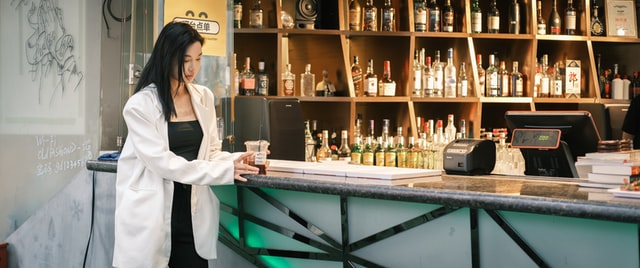Soju and baijiu are two of Asia’s national drinks. Due to their similarities, there can be a lot of confusion between soju and baijiu. After all, both are clear, grain-based distilled spirits that are traditionally drunk neat. Both are made from rice, have sweet flavors and can be enjoyed year-round. But despite this, the two spirits are fundamentally different. How? Read on to find out…

What are the differences between soju and baijiu?
There are lots of differences between these two Asian spirits. We’ve listed some of the main ones below. Can you think of any others? If you can, feel free to get in touch!
Availability
Despite baijiu being more difficult to make (more on that below), it’s actually often easier to get hold of than its Korean equivalent.
China’s alcohol culture stretches back centuries, with an entire genre of Chinese literature devoted to drinking. This is reflected in the country’s easy-going position on alcohol access.
While in Western countries, alcohol is bound by labels and laws, in China, you can find baijiu almost anywhere. By the side of the road; sold in shops in plastic bags – anything goes, seemingly.
Outside of their home countries, both are relatively simple to get hold of.
A wide variety of baijiu can be bought around the world. One of the most popular and historic, Ming River, dates back to 1573 and can be bought easily on Amazon.
Similarly, the most popular soju in the world, Jinro Chamisul Fresh, can be picked up with its Original counterpart for just a few pounds or dollars.
Ingredients
Have you ever stopped to think what’s inside your favourite drinks? While baijiu and soju may look pretty similar, the contents are actually quite different.
Soju is brewed from rice (or potato), water, and sugar or sweetener. A special fermentation agent called nuruk is often added while it’s produced as well.
Baijiu, on the other hand, is normally made from a fermented cereal plant called sorghum, as well as a distinct type of yeast-like microorganism called Qū.
Though both include an ingredient to kickstart the fermentation process, the key components are completely distinct. This also results in the way the drinks are created being pretty different, too.

Production method
Soju and baijiu are both distilled spirits, but the number of times the spirit goes through the process differs completely during the process.
Soju is distilled once, but for anything up to fifteen days. Baijiu, on the other hand, is distilled up to seven times.
Baijiu is also usually left to mature for longer. Ming River is aged for at least two to three years, whilst this Fen Chiew is aged for ten years.
Soju, on the other hand, is normally bottled once it’s distilled, though certain rarer brands are allowed to mature before they’re prepared for sale.
Unsurprisingly, these different methods also affect the flavour…
Taste
Both beverages are distilled for a smoother taste. But that’s where the similarities end.
Baijiu is favored for its sweet, fragrant flavour. It’s been described as “funky, with a rotting, sweet fruit flavor and a touch of nuttiness”, “smooth and sweet” – or less charitably, tasting like “liquid razor blades”.
Meanwhile, South Korea’s national drink, is a bit like a sweeter vodka, and is more comparable to sake. Of course, if you’re drinking flavoured soju, this will taste more like whatever it’s flavoured with! This could be lychees, strawberries, or even coffee!
Whether or not the taste difference is enough to convince baijiu drinkers to switch to soju remains to be seen.
But what might make the difference is the price.
Price
In a world that’s experiencing a cost of living crisis and increasing inflation, budgeting is tricky but vital.
One of the easiest ways for the discerning drinker to save money is to buy a cheaper variety of alcohol. But sometimes, this can depend on availability and location.
We’ve written a whole article on why soju is so cheap in Korea. But because it’s the world’s most popular spirit – partly because of the huge Chinese population – baijiu is even cheaper.
Of course, there are expensive varieties of both. But at the top end, baijiu wins hands down. The most expensive Moutai baijiu can sell for up to $220 a bottle. Aged baijiu can go for even more at auction.
Why? Because of the time it takes to produce. As we’ve said above, the product can go through multiple distillations. At ten years before it’s bottled for the most aged, we’ve drunk younger whiskeys!
There are expensive types of soju, including Gowoon Dar, which goes for about $275 a bottle. However, this is extremely limited edition, artisanal soju. Some may say that the price is artificially high because of that.
This is often left to age in casks, driving up the price due to its rarity.
Popularity
This one’s simple. Baijiu is the world’s most popular spirit. South Korea’s national drink is soju, but when it comes down to amounts drunk, baijiu takes the lead because China’s simply much bigger.
Maybe this is partly because of its age. Soju made its appearance in South Korea around 1,000 years ago, when monks mixed rice wine with cane sugar, then cooked the concoction. Baijiu, meanwhile, dates back to the Tang Dynasty (618-907).
Don’t get me wrong. Soju’s massively popular in South Korea, with the average Korean drinking six bottles of the stuff a year (and some much more!).
But baijiu beats it decisively in terms of quantities drunk annually.
What are the similarities between soju and baijiu?
Despite all these differences, there are quite a few similarities between the spirits as well. These include:
- Clarity – they’re both clear, transparent white spirits.
- How they’re served – they’re both traditionally drunk out of shot glasses. We have an article here about the best soju glasses, which would equally work fantastically well for baijiu too!
- Mixability – though this is non-traditional, both are increasingly being used in cocktails and mixed drinks. In particular, soju is commonly found mixed with other alcoholic drinks. Soju and beer, known as somaek, and even soju and Yakult are popular in Korea these days!
Conclusion
So there you have it. Despite appearances, there are loads of differences between baijiu and soju.
The taste, production method, and ingredients are all key to making these two similar looking white spirits actually very different in reality.
Why not try them both for yourself and see?
For beginners, we recommend Ming River baijiu and Jinro Chamisul soju.
